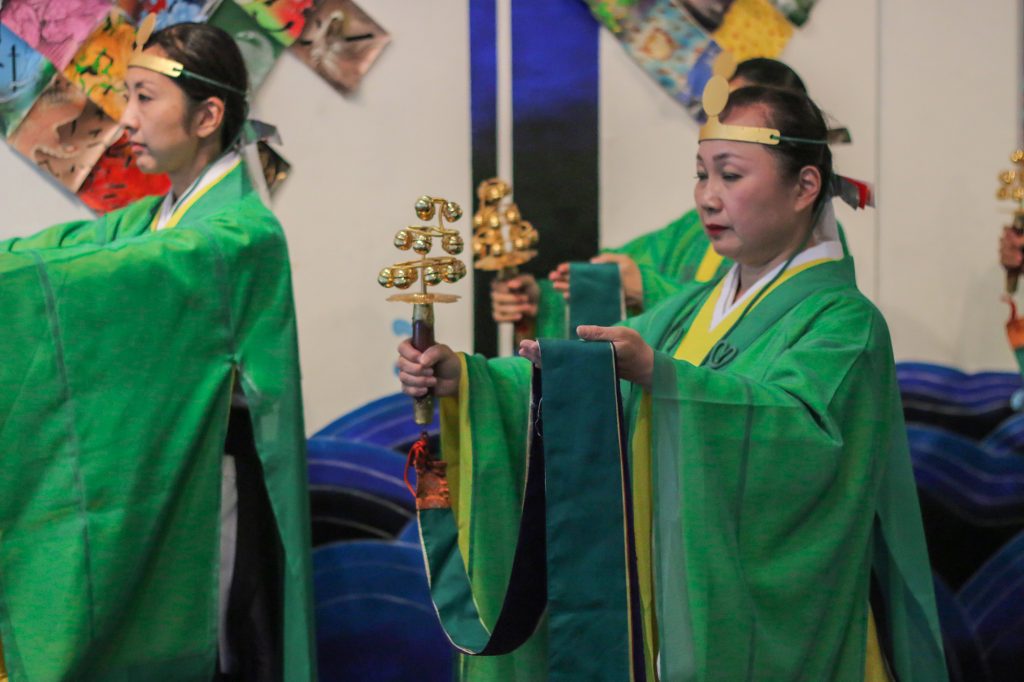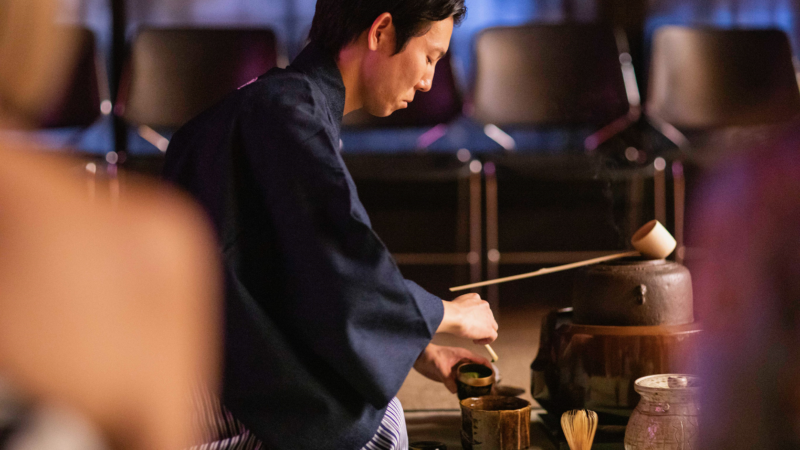July 6, 2016 ◆ George Tsouris
It is frequently taken as common knowledge that Japan’s culture is unique as a result of developing in its isolated island setting. However, this perspective ignores the connections and communications that Japan has continuously had for thousands of years with mainland Asia, and even direct and indirect relations with Europe and the rest of the world. Indeed, from ancient times the Silk Road transmitted culture across the Eurasian continent; and even during the period of Sakoku, or closed country policy in Japan from the 17th to 19th century, Japan was open in the Kyushu port city of Nagasaki. Resobox’s recent opening reception of Yuki Ideguchi’s Vortex exhibition was accompanied by a traditional Shintoceremonial K
The coupling of this kagura performance from Miyajidake Shrine with Mr. Ideguchi’s contemporary take on traditional Edo-style ukiyo-e art shouldn’t be seen as random. He hails from the same region in Japan as the Miyajidake Shrine, Kyushu, the south-western most of Japan’s main islands. This is important because of the unique cultural aspects found in Kyushu that are distinct from other regions of Japan. One of the more interesting elements found in Mr. Ideguchi’s paintings is the role multicultural influences have played in the development of the region; amongst his traditional Japanese themed paintings, you will find accents from cultures around the world. This is natural seeing as his home town of Nagasaki was, during the closed country sakoku era, the only port that was open to foreigners. As a result, this region was the only part of Japan that was exposed to foreign ideas during that time. This can be reflected in Mr. Ideguchi’s Catholic upbringing. It is, perhaps, this interesting feature of Kyushu’s cultural landscape that allows his art to reflect a diverse range of religious and cultural influences from Buddhism, Christianity, Mexican, and scientific worldviews, all the while working in a contemporary manifestation of traditional Japanese styles.

Despite the uniquely local style of a uniquely Japanese ritual, it is also important to recognize the multicultural aspects of the Miyajidake Shrine’s kagura performance. The 35 years that some of the performers have trained reflects a tradition that goes back over 2000 years. The story goes that King Azumi came to Fukuoka area of Kyushu from mainland Asia (most likely from Korea) and brought with him this special form of the ritual dance and music. That King Azumi is recognized to be from the mainland reveals the multicultural beginnings of Japanese culture and history. It was spoken with pride that the ancient contribution of the Silk Road connection to the European, Indian, and Asian worlds. Such contributions to Japanese tradition involve all aspects of life, including economics, technology, and culture. This sense of oneness could be seen in the kagura performance, which reveal the ancient continental influence on music and dance, all expressed in a Japanese way.
The four white clad musicians were seated to the left edge of the stage, leaving most of the stage empty to start. The performance began with a long solo note from a fue Japanese flute. This was the tone to welcome in the five female mikodancers, or shrine maidens. They were all adorned with the green draping haorikimono robe and with yellow and purple hakama trousers. In addition to the musicians to the side of the stage, the miko also played kagura suzu, similar to jingle bells.

Amongst the musicians was a female singer whose slow deliberate singing served as a counterpoint to the Japanese melody produced by the fue flute. At regular rhythmic measures, the singer also added a clap with her shakubyoshi wooden clappers, along with another’s clap of the chappa, small hand cymbals. Then the fourth musician would strum a moment’s melody on the stringed koto instrument.While easy to appreciate the uniquely Japanese feeling of the rhythm and melody, a careful listening is rewarded when you finally discover the familiarity in the beat and notes.
The meditative music matched the carefully choreographed movements of the dancers. It wasn’t clear if it was the music leading the dancers, or the dancers leading the music. It would probably make most sense to understand them in tune with each other’s spirituality in order to achieve the goal of the kagura performance: communication with the kami, Japanese gods that imbue every object and element of the world. This spirituality with all surroundings was translated in the movements of the miko, which seemed to be in thematic sections for each direction: left, right, front, back, and down and up; that is, all surroundings. Even the space was maximized to transmit this sort of message; during one section they spread to take up most of the space, and then later came together to appear as one. This feeling of oneness was present from the beginning, since their movements were always synchronized and matched each other. Perhaps this was all to remind the audience that we are always also one with the music around us, one with our surroundings, and one with the spirituality that emanates from everywhere and everything and everyone.






